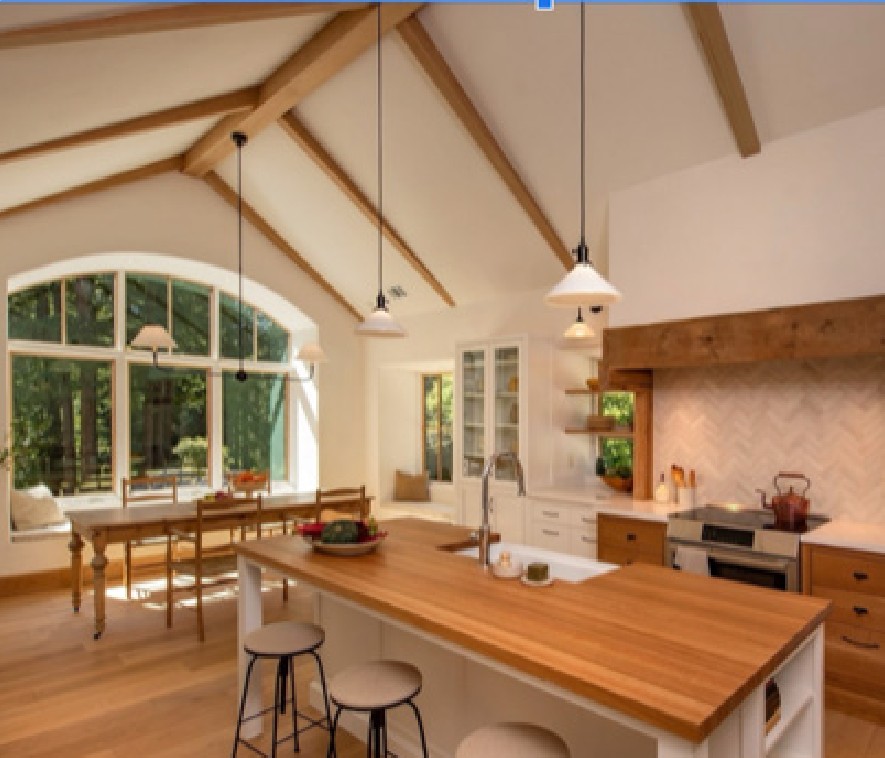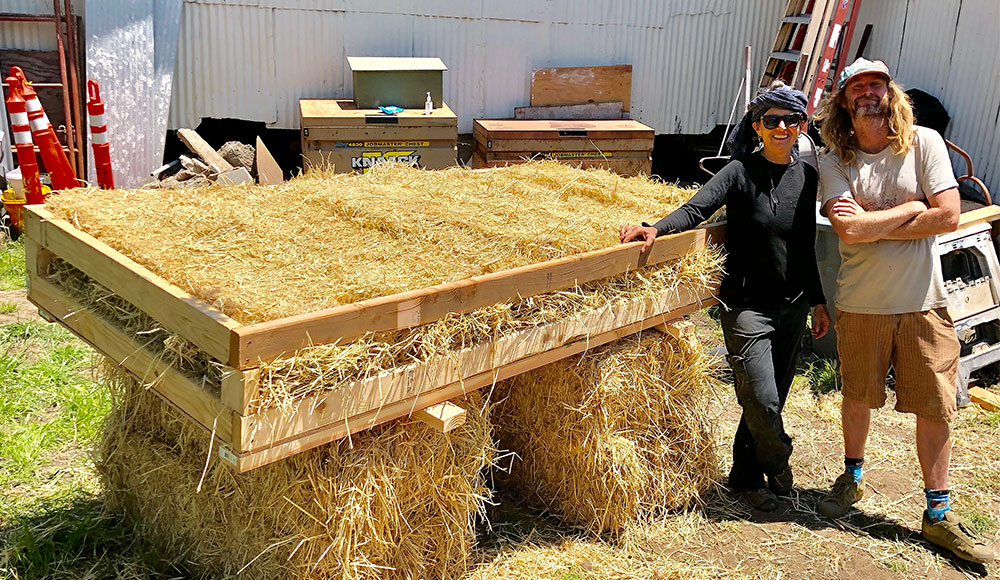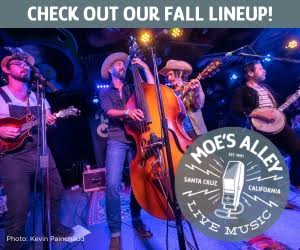For some people, Pele Juju is a core memory. The Santa Cruz–based all-women world beat band created a tremendous grassroots and national following in the late ’80s and early ’90s.
As the band performed, toured and played large festivals, including Reggae on the River, the Los Angeles Street Scene and the Winnipeg Folk Festival, lead guitarist Michele Landegger also worked as a carpenter.
These days you won’t find her on stage, but Landegger is thriving in a new vocation as president of Studio Boa, a full-service design and construction company emphasizing green, natural and sustainable building practices, with a strong focus on design and construction of accessory dwelling units (ADUs).
You might say Landegger has come full circle. “My take on it is, music and art are such an integral part of human need and who we are, as well as food and shelter,” Landegger said. “I happened to diverge into shelter.”
Licensed as general contractor in 1988, Landegger founded Studio Boa (formerly Boa Constructor Building & Design) along with partner/lead designer Debrae Lopes. “We developed the design build aspect of Boa Constructor together through our own homesteading process in 1996,” Landegger said. “When I left the band in 1995 we bought 20 acres of raw land in 1996 and started building.”
Initially, Landegger studied through the CETA program at Cabrillo College. The Comprehensive Employment and Training Act (CETA) is a discontinued U.S. federal program for training and employment. “I became a builder here because of Cabrillo College,” Landegger said. “I went to a federally funded program that trained women and BIPOC folks in the trades.”
While being a woman in the trades is challenging, Landegger was hired by a variety of male contractors, who helped develop her into a highly skilled carpenter. “I started in solar thermal and was hired by a solar contractor and moved into carpentry,” she said.
As she redefined her career, Landegger set about to integrate energy-efficient, nontoxic building and solar design into affordable housing. “As a builder, the focus I take now is toward ADUs and how important they are to community, affordable housing and infill housing,” she said.
Repurposing Agricultural Waste
A key motivator in Boa design is the implementation of carbon drawdown, or carbon sequestering. “Straw bale captures carbon from being released into the atmosphere, so straw is really a great viable material,” Landegger said. As cars, buildings and manufacturing release CO2, carbon sequestering is another way to reduce our carbon footprint, not only decreasing but also storing these gasses from release into the atmosphere.
“Buildings account for 40% of CO2 in the atmosphere,” Landegger said. “Changing how we build can have an incredibly significant effect on our climate future.”
Being able to infill with ADUs for more multi-generational housing is seen as a current trend, and Studio Boa’s response was to create an ADU profile using a panelized 12-inch wall system of fire-resistant straw. Landegger has built a number of 1,200-square-foot homes where the larger, main house could still be built on a parcel over an acre. In the city of Santa Cruz, that allowance is up to about 800 feet depending on size of the lot. “We created a straw panel ADU that’s 499 square feet,” she said. This prefab ADU design also enables owners to avoid a soils report, she noted.
Locally, Boa’s work can be found throughout Santa Cruz County—for example, the Sullivan family’s 2,160-square-foot straw bale home near the intersection of Capitola and Wharf roads. The home’s craftsman exterior was built of straw bales covered with a plaster exterior and blends seamlessly with the neighborhood. (The interior has earthen plaster.)
As described by Mother Earth News magazine: “The home’s airtight straw bale walls and recycled cellulose insulation create a building envelope that helps the thermal mass retain heat or coolness, which releases over time, keeping the house at a comfortable temperature,” writes the author. (“Solar in the City,” Issue No. 210, June/July 2005)
“And we have built many straw bale homes and ADUs, and a straw panel prototype ADU in the Grant Street Park area in the city of Santa Cruz,” Landegger said. That list also includes a straw bale home for a family that lost theirs in the CZU Lightning Complex Fire in Boulder Creek, and energy-efficient builds in Scotts Valley and Watsonville. Altogether, Boa has constructed about 13 straw bale homes in Santa Cruz County and many more homes, additions and remodels using stick frame.

Fire Resistant and Renewable
Straw coated with plaster is a fire-resistant medium, and Studio Boa has built many homes with straw, along with standard-construction framed houses too. A bio-based material, straw is not only fire- and pest-resistant but also renewable, Landegger said. Homes built with straw as infill insulation, and coated with plaster “stucco,” have been tested as two-hour fire rated, compared to the average stick frame home with stucco, which is rated as one hour. “This is due to the dense pack of the straw, as opposed to channels of framing with a less dense fiberglass insulation,” Landegger explains.
One uniquely cool feature of nearly all straw bale homes is a “truth window,” a panel that opens to reveal the straw used in building. Straw also has no pest problems because it’s tightly encased. “It’s really resistant to pests and fire,” Landegger said. In Nebraska, there are houses still standing that were built from straw in the 1800s, when wood was not readily available, she says.
Recent innovations in straw such as straw blocks and panels have also expanded options so people are no longer limited to full bales.
Straw is a waste byproduct from food production—wheat and barley stalks—both of which bring down pollution while being highly insulative, Landegger said. “Then we can really solve a couple problems at once by sequestering carbon dioxide in building houses. Two defining issues of our time are climate crisis and affordable housing. Natural building is at the intersection of those two crises,” she said.
Circling back to Pele Juju, the original eight-person lineup disbanded in the late 1990s, and Landegger played lead guitar for 10 touring and recording years with Pele. From its humble beginnings as a garage band, Pele Juju grew into a community event. “It’s amazing what an iconic band it was,” Landegger said. “It was born in the community. We grew in the community. … It was a magical time for all of us in terms of creativity and the importance of art and music in our community.”
Ultimately, Landegger believes the band succumbed to the pressure of success and the press to become more commercialized. Lead singer Dana Hutson “really lifted the whole band up to another level. I don’t think we did any covers at all,” Landegger said. Brindle, the iconic hand drummer percussionist, passed away in 2009, and a few men even joined in various iterations of the band over the years, she added, including drummer Rick Walker, Gary Regina and Bob Burnett. “We are all spread out and doing different things,” Landegger says. “I left kind of at the peak of the success.”
According to Last FM website, Pele Juju was voted five times in a row in the ’90s as Best Local Band in a Santa Cruz readers poll. “So many of our arts need support in the material world,” Landegger added. “I had to support my family. I couldn’t do it as a gigging musician.” Now, she expresses her love of art through building local community.
For more information about Studio Boa Green Design Build, visit studioboa.com, call 831-334-1147 or email michele@studioboa.
Explore more stories from our 2025 Home & Garden issue.













